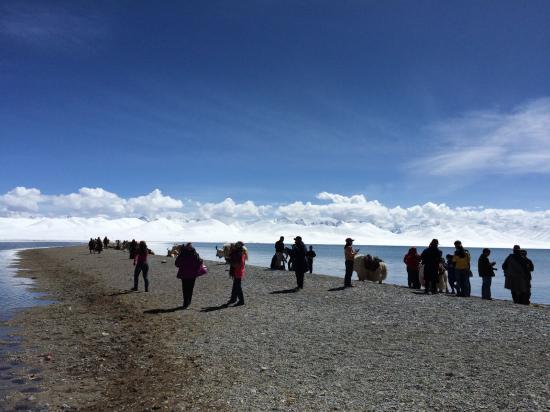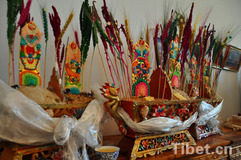Lhasa to open two large-scale countryside tourist routes this year

Lhasa possesses three world cultural heritage sites: the Potala palace, the Jokhang Temple, and the Norbulingka; it also possesses in abundance intangible cultural assets such as Tibetan Opera, thangka painting, and Nyemo Tibetan incense; it offers as well unique and distinguished holidays including the Lhasa Shoton festival the Damxung Horse Race festival; furthermore it has mystical religious culture.
In recent years along with the gradual improvement in economy, tourism to countryside destinations has been rapidly developing. This year, in order to adapt to the new common conditions surrounding tourism, the Lhasa Tourism Bureau has established more closer ties and contacts with a series of countryside tourist sites, creating two large-scale eco-tourist loops in Tibet.
Loop One
Possessing numerous tourist resources
Facilitating as the countryside tourism golden route
“Lhasa, Pure Land Health Industry Garden District, Junpa Fishing Village, the Thonpa scenic area, Nyemo, Qiongmugangga scenic area, Xumai Hotspring, Yangbajing, Damxung, Rezhen Forest Park, Drigunggou scenic area, Dezhong Hotspring, Ritoq Hotspring, Sijinlacuo, Gyama acenic area, Caigongtangzhigou, ship tour along the Lhasa River.” This large-scale Lhasa countryside eco-tour loop includes scenic areas in two districts of six different counties, along which people could experience the unique Tibetan folklore culture.
Day One
At 8:00 a.m. from Lhasa people will depart for Caina Township of Chushur County, and thereat visit the Lhasa Pure Land Health Industry Garden District which includes botany viewing, exhibition area for specialty products, Tibetan medicine museum, and Maca processing plant.
Departing from Caina, the tour passes along the Lagong Highway all the way to the Quxu Exit and then it travels along the sub-route for 8 kilometers until it arrives to Junpa Village, the only village in Tibet that depends on fishing for subsistence.
Around 10:00 a.m. the tour returns back to the Lagong Highway. On the way it passes through the Gala Mountain Tunnel, and Samey Village in Chushur County where peach blossoms can be seen every year from March until April, and heads into Thonpa scenic area in Nyemo County.
The Thonpa scenic area is the place where the creator of Tibetan character and incense Thonmi Sambhota was born. The area possesses several intangible cultural assets of both national and autonomous regional levels.
At 13:00 p.m. the tour leaves from Nyemo and passes through Qiongmugangga scenic area in which can been seen Mt. Qiongmugangga and after continuing onward for about 150 kilometers the tour arrives to the Xumai Hotspring. The surroundings thereat are very beautiful.
Around 17:00 p.m. the tour arrives to Yangbajing, hereat, the extremely hot vapors plume up and manifest along the hills as thick as white snow, and thereby create a contrasting and bizarre beauty along the alpine snowy terrains. It is possible to stay for the night and soak in the hot springs.
Departing from Yangbajin the tour continues along the National Highway 109 into Damxung County, and along the way passes by the Tanggula mountain range and after proceeding for 65 kilometers it arrives to the Namtso National Park at which Namtso Lake can be seen.
Day Two
At 9:00 a.m. the tour leaves Damxung County and heads toward the Rezhen River Valley Forest Park proceeding for about 130 miles. The Rezhen National Forest Park was officially established by the state in 2004. The park has 220,000 junipers that are 1,000 years old, and the 30-kilomete-long Rezhen river valley makes for a unique looking site.
At the base of the local mountains is situated the wel-known Rezhen Monastery. Departing from the Rezhen scenic area, the tour heads along the provincial Route 202 going to Zhigonggou scenic area in Medrogungkar County, the duration is about 70 kilometers or so and the Zhigongti Temple can be seen along the way.
After visiting the temple the tour heads onward to the Dezhong Hotsprings, which is a scorching 40 degrees hot celsius. It is spouting with water and has reasonable depths and shallows, and furthermore is able to treat a variety of chronic diseases. In addition, it is feasible to take a bath during all four seasons of the year.
Day Three
At 8:00 a.m., the tour leaves from the Dezhong Hotsprings and heads out along National Road 319 for the Ritoq Hotspring scenic area, the tour stops briefly thereat before proceeding to the Sijinlacuo. Surrounding the lake, rolling mountains are quite abundant in medical plants.
Then the tour returns to Medrogungkar county city for lunch, and later heads onward to the Gyama scenic srea, the birthplace of the 33rd Tubo king Songtsen Gampo (617-650 A.D.). On the way back to Lhasa, visitors could enjoy the view of Ganden Monastery and experience the linka culture (traveling in gardens) in Taktse County.
Day Four
The tour hikes for Nyangri and Duodi valleys where visitors could enjoy agritourism and Tibetan banquets . In the evening, the splendid scenery along the Lhasa River can be seen by ship.
Loop Two
Good Place for Leisure
Experiencing Lhasa’s most beautiful countryside tour
“Lhasa, Tohlung Dechen District, Tsurpu Monastery, Qubsang hotsprings, Yangbajin, Damxung, Rezhen Forest Park, Zhigonggou scenic area, Dezhong Hotsprings, Rutoq Hotsprings, Sijinlacuo, Gyama scenic area, Caigongtangzhi Valley, Lhasa city area as well as night time scenery aboard a ship.” The second route departs from Lhasa passing through the Tohlung Dechen District and the Tsurpu Monastery, and then onward to Yangbajing, from there the route are the same as the loop one.
The Lhasa City Tourist Bureau sincerely invites tourists from home and abroad to come to Lhasa, take a leisurely rest and experience the most beautiful countryside tour there.
Your Comment
Name E-mailRelated News
-
;
-
-

-
Tibet launches tourist routes to experience Tibetan New Year
Losar is the grandest festival with the richest folk flavor among the numerous Tibetan festivals. During this festival, various kinds of folk activities will be held in Tibet.
-
-
-

-
Guide of air routes, highways, rail networks to Tibet
The article shows progresses made in air routes, highways, and rail networks in southwest China's Tibet Autonomous Region.
-
Based in Lhasa, Tibet Vista is a Tibet travel agency that specialized in Tibet permit, and Tibet tours for both private and group travelers at a local price!
•4 Days Lhasa City Group Tour from USD 460 •8 Days Everest Base Camp Group Tour from USD 850 •15 Days Mt.Kailash Group Tour from USD 1780 •2016 Tibet Train Tours from Beijing, Shanghai, Chengdu, Xining,etc











